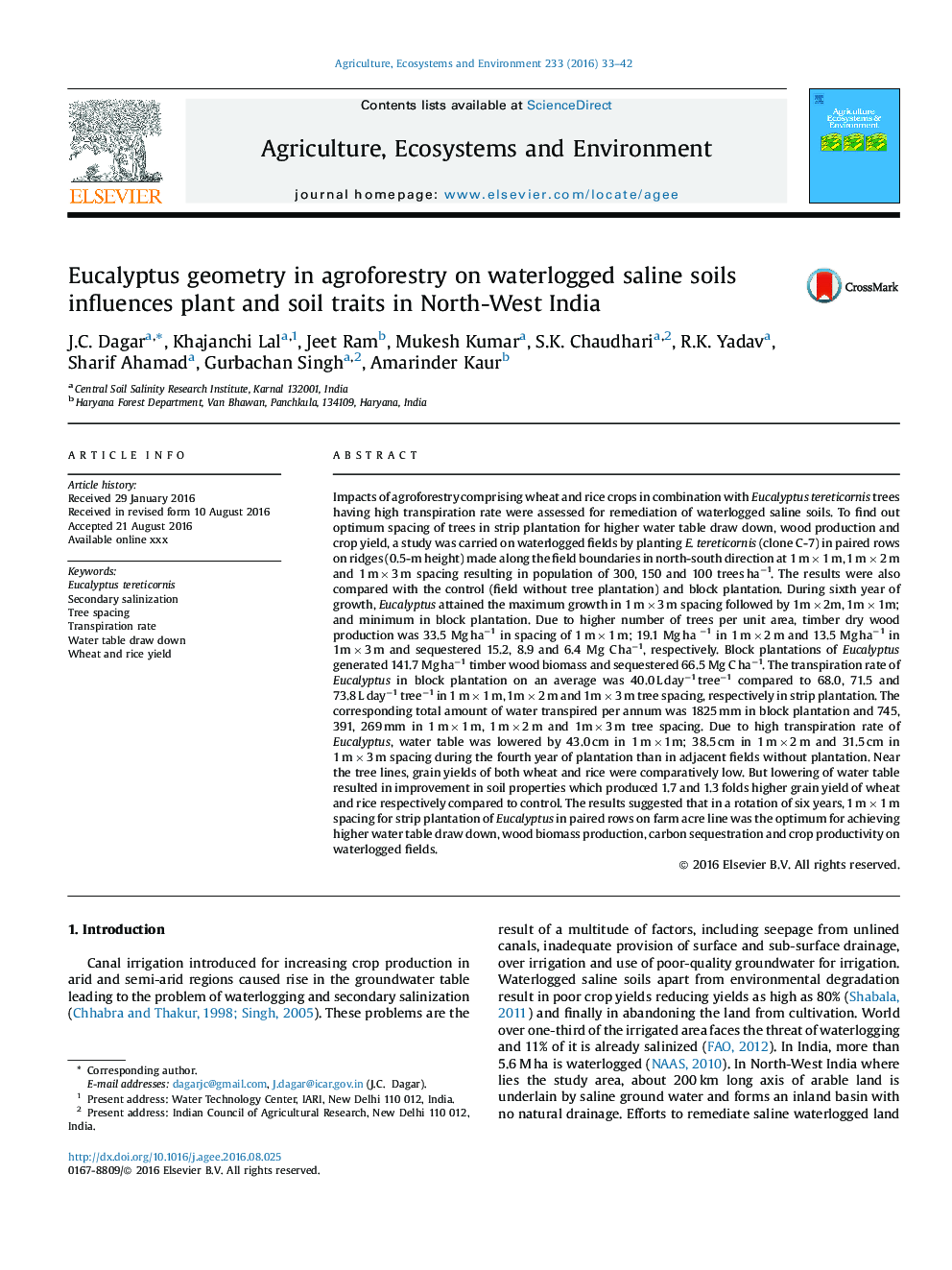| کد مقاله | کد نشریه | سال انتشار | مقاله انگلیسی | نسخه تمام متن |
|---|---|---|---|---|
| 2413466 | 1552019 | 2016 | 10 صفحه PDF | دانلود رایگان |
• In agroforestry, Eucalyptus can be used for increased water table draw down, wood biomass production and carbon sequestration.
• Eucalyptus should be planted in paired-row strips at 1m × 1 m spacing on farm acre line in a rotation of six years.
• Lowering water table improved soil properties and crop productivity.
• Block plantation effectively increased water table draw down, but poor farmers go for agroforestry model as they need regular returns.
• This model can be adopted elsewhere with similar conditions in the world.
Impacts of agroforestry comprising wheat and rice crops in combination with Eucalyptus tereticornis trees having high transpiration rate were assessed for remediation of waterlogged saline soils. To find out optimum spacing of trees in strip plantation for higher water table draw down, wood production and crop yield, a study was carried on waterlogged fields by planting E. tereticornis (clone C-7) in paired rows on ridges (0.5-m height) made along the field boundaries in north-south direction at 1 m × 1 m, 1 m × 2 m and 1 m × 3 m spacing resulting in population of 300, 150 and 100 trees ha−1. The results were also compared with the control (field without tree plantation) and block plantation. During sixth year of growth, Eucalyptus attained the maximum growth in 1 m × 3 m spacing followed by 1m × 2m, 1m × 1m; and minimum in block plantation. Due to higher number of trees per unit area, timber dry wood production was 33.5 Mg ha−1 in spacing of 1 m × 1 m; 19.1 Mg ha −1 in 1 m × 2 m and 13.5 Mg ha−1 in 1m × 3 m and sequestered 15.2, 8.9 and 6.4 Mg C ha−1, respectively. Block plantations of Eucalyptus generated 141.7 Mg ha−1 timber wood biomass and sequestered 66.5 Mg C ha−1. The transpiration rate of Eucalyptus in block plantation on an average was 40.0 L day−1 tree−1 compared to 68.0, 71.5 and 73.8 L day−1 tree−1 in 1 m × 1 m, 1m × 2 m and 1m × 3 m tree spacing, respectively in strip plantation. The corresponding total amount of water transpired per annum was 1825 mm in block plantation and 745, 391, 269 mm in 1 m × 1 m, 1 m × 2 m and 1m × 3 m tree spacing. Due to high transpiration rate of Eucalyptus, water table was lowered by 43.0 cm in 1 m × 1m; 38.5 cm in 1 m × 2 m and 31.5 cm in 1 m × 3 m spacing during the fourth year of plantation than in adjacent fields without plantation. Near the tree lines, grain yields of both wheat and rice were comparatively low. But lowering of water table resulted in improvement in soil properties which produced 1.7 and 1.3 folds higher grain yield of wheat and rice respectively compared to control. The results suggested that in a rotation of six years, 1 m × 1 m spacing for strip plantation of Eucalyptus in paired rows on farm acre line was the optimum for achieving higher water table draw down, wood biomass production, carbon sequestration and crop productivity on waterlogged fields.
Journal: Agriculture, Ecosystems & Environment - Volume 233, 3 October 2016, Pages 33–42
